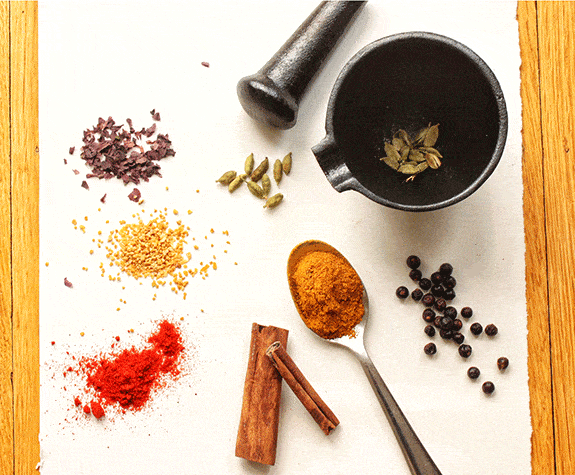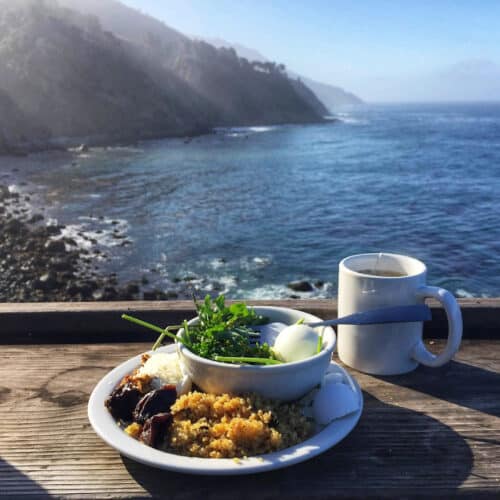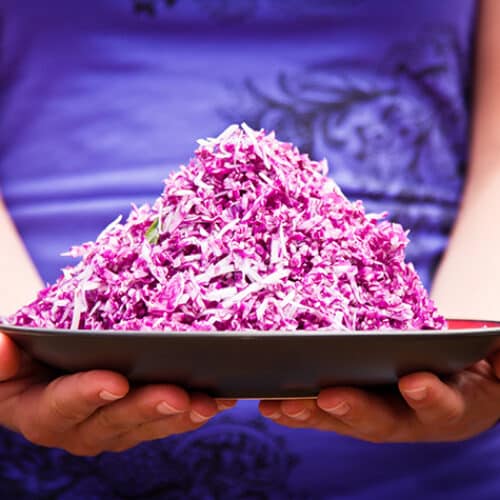A Culinary Pharmacy with Herbs + Spices
I’ve been building my culinary pharmacy for many years now. It includes everything from the foods I prepare, plants from land and sea, to power-packed herbs and spices. Like anything, creating a culinary pharmacy is a process and can be tailored to your taste preferences, interests, and level of adventurousness. When customized to your liking and executed with a bit of know-how, it can impact your mind and mood! Your culinary pharmacy can include anything from what you feed your mind through thoughts and beliefs to what you physically consume regularly. For now, I’m going to focus on ways you can begin your culinary pharmacy with power-packed nutrients that come in the form of big flavors – herbs and spices!
Culinary herbs have long been used not just for their exquisite flavors but because they naturally support detoxification due to chemicals called phenols and sulfur compounds, amongst others. For example, garlic, rosemary, and onions are essential for supporting detoxification and can be used in your daily cooking to enhance detoxification.
Let’s start with some impactful basics to support a healthy body that can impact memory, mood, sleep, and energy levels. Are you ready? Ok, let’s begin!
*Content below is shared with permission from Catherine Furst at The Center for Mind-Body Medicine and adapted from The Healthy Mind Cookbook by Rebecca Katz.
———
Basil
Full of flavonoids that associated with cognition and may reverse age-related declines in memory and learning. Basil also is full of magnesium which promotes better sleep.
- Potential health benefits: Antibacterial, anti-inflammatory, antioxidant, antispasmodic, vitamins, and minerals.
- Culinary uses: Pesto, tomato sauce, in salads and smoothies, in a soup, as a rub for fish, poultry, meat. Mediterranean or Asian flavor.
———
Cardamom
Loaded with B vitamins that can help lessen fatigue, cardamom also contains thiamin that supports concentration while boosting energy levels! It’s also rich in compounds that help fight inflammation.
- Traditional uses + Potential health benefits: Originated in India, its the main ingredient in a traditional herbal remedy there.
- Culinary uses: The pods of cardamom are used for flavoring in Indian cuisine and in beverages such as coffee and tea. It is used worldwide in both savory and sweet recipes.
———
Cinnamon
Loaded with powerful medicinal properties that help reduce insulin resistance. Cinnamon is also appealing for the positive impacts it has on the brain in studies on mice around the brain’s main memory center, the hippocampus. According to the Journal of Neuroimmune Pharmacology, cinnamon may help prevent a variety of age-related neurological disorders like Parkinson’s.
- Traditional uses + Potential health benefits: Anti-microbial, blood sugar management, antispasmodic, digestive aid.
- Culinary uses: Whole grains (ex. oats), soups, stews, chili, fruit, beverages, baked goods
Cooking Tip: Begin sprinkling cinnamon into tea, coffee, or smoothies is a simple way to start incorporating this healing spice each day.
———
Cumin
A rich source of iron, important for women in their child-bearing years, cumin is wonderful for people with anemia.
- Traditional uses + potential health benefits: Immune support and digestive aid
- Culinary uses: Dips, soups, sauces, or as a rub for fish, poultry, and meat
Cooking Tip: Fantastic for curries, but also delicious on sweet potatoes, eggs and in bean chili.
———
Coriander
Coriander is the seed of the cilantro plant. Both cilantro and coriander have been shown to boost memory in mice. Also, the roots are high in potassium and iron.
- Traditional uses + potential health benefits: Anti-spasmodic, vitamins, essential oil, digestive aid
- Culinary uses: Pickling, curries, soups, marinades
Cooking Tip: Use in pesto in place of basil, add to guacamole, hummus or to add color and another flavor dimension. Fantastic on soups and stews and tossed into salads.
———
Dulse
Dulse is a red sea algae that can be eaten fresh, dried, or even pan-fried, adding a salty flavor to foods. They are a good source of vitamins, trace minerals, protein, and healthy fatty acids. The ocean-like flavor of dulse doesn’t appeal to all, but some say it tastes like bacon! Either way, the mineral-rich benefits of dulse, especially high in iodine, keeps the thyroid buzzing along. Sea vegetables (dulse and kelp, for example) and algae contain polysaccharides, a form of plant sugars, which bind heavy metals and other toxins, facilitating their elimination.
- Traditional uses + potential health benefits: Support the digestive process and the functioning of the digestive enzymes
- Culinary uses: Salads, salad dressings, soups use as an alternative to salt.
Cooking tip: Sprinkle into soups, popcorn or as an alternative to salt for any of your favorite foods.
———
Garlic
Garlic falls within the allium family that helps reduce the risk of cardiovascular disease and directly related to better brain functioning. The active component in garlic is the sulfur compound called Allicin.
- Traditional uses + potential health benefits: Antioxidant, lowers LDL, raises HDL, anti-inflammatory, prevents cerebral aging, anti-clotting, boosts immunity, antibacterial
- Culinary uses: Salads, soups, stews, chili, marinades, dressings
Cooking tip: Allicin is produced as a result of chemical reactions when garlic is chopped, chewed, or bruised. Heating the garlic immediately after chipping or whole doesn’t have the powerful medicinal benefits. It’sIt’s best to cut or chop the cloves and let them sit for 10-15 minutes to give the medicinal compounds a chance to form.
———
Ginger
Known for its support with motion sickness and nausea, it’s also a great digestive aid and helps improve the absorption of essential nutrients in the body by stimulating gastric and pancreatic enzyme secretion. It also helps to improve memory loss after a stroke in rat studies.
- Traditional uses + potential health benefits: Antioxidant, improves osteoarthritis, anti-emetic (prevents vomiting), anti-inflammatory, anti-microbial, immune-boosting, anti-spasmodic, digestive aid, improves circulation, reduces nausea
- Culinary uses: Marinade for fish, poultry, meat; chutneys, smoothies, tea, soups; baked goods, stir-fries, and can be candied. Asian style cuisine.
Cooking Tip: Use in stir-fries and fish dishes or add to soups. Make a simple ginger tea by steeping one tablespoon of finely chopped fresh ginger in 2 cups of boiling water for 10 minutes.
———
Mint
A great source of Vitamin A that helps promote learning skills and increases the brain’s plasticity.
- Traditional uses + potential health benefits: Digestion and anti-microbial
- Culinary uses: Pesto, herb rub, salad, smoothies, in beverages, dressings, marinades, dips, soups, and stews
Cooking Tip: Steep in tea or chop it up and use it like you would use parsley. Spearmint is great for cooking since it’s more intense and volatile compared to peppermint. Fresh mint also adds bright and delicious notes to salads or mixed into guacamole!
———
Oregano
Rich in vitamin K supporting both cognitive health and better memory, oregano is are now being looked at to support cognitive function. It also has a compound called carnosol, which is a promising anti-cancer and anti-inflammatory agent according to research.
- Traditional uses + potential health benefits: Antioxidant, anti-microbial, antispasmodic, antibacterial, astringent, digestive aid, immune-boosting, essential oil
- Culinary uses: Vegetables, bread, salads. Mediterranean and Mexican style cuisine.
Cooking Tip: Combine into salads sprinkle onto eggs or mix into roasted veggies. Oregano is delicious on grilled fish and added into tomato sauces with sauteed garlic.
———
Parsley
Full of a flavonoid called luteolin found in abundance in parsley has been linked with improvements in memory, according to studies. It’s also loaded with vitamin A supporting overall brain health.
- Traditional uses + potential health benefits: Antioxidant and anti-microbial
- Culinary uses: Marinade for fish, poultry and meat, salads, smoothies, water, dressings, marinades, dips, soups, stews. World cuisine.
———
Rosemary
Rosemary has long been linked in folk medicine to better memory. Vitamin A rosemary may help to boost learning skills, while vitamin C can elevate your mood. Additionally, Therapeutic Advances in Psychopharmacology also show the aroma from rosemary can help improve a person’s concentration.
- Traditional uses + potential health benefits: Anti-spasmodic, antibacterial, digestive aid, improves circulation, essential oil
- Culinary uses: Poultry and meat dishes, herb butter, salad dressings, soups
———
Chile Peppers
Wonderful for adding heat, chile peppers have a compound called capsaicin that is responsible for it’s the hot and spicy flavor. They also produce antidepressant effects in certain studies.
- Traditional uses + potential health benefits: Antioxidant, weight management
- Culinary uses: Marinades, sauces, soups, stews, salsas, Asian, Mediterranean, African flavor.
———
Turmeric
The beautiful color of turmeric is a result of its active ingredient called curcumin. It’s been shown to be health-supportive in many ways from cognitive functioning to cardiovascular disease. Turmeric has been popular in India for more than 5,000 years and is thought to be one of the primary reasons why both are India’s rural and urban populations have among the lowest rates of Alzheimer’sAlzheimer’s disease in the world. Read more about the studies here.
- Traditional uses + potential health benefits: Anti-inflammatory, anti-cancer, bile stimulant, digestive aid
- Culinary uses: Bean dips, dressings, marinades, sauces, smoothies, soups, stews, rubs, teas.
———
I hope this gives you a good start towards understanding the benefits of herbs and spices for creating a powerful culinary pharmacy in your own home. As you build your personal pantry, I’d love to hear how you’re using them in your recipes! I look forward to hearing from you.



